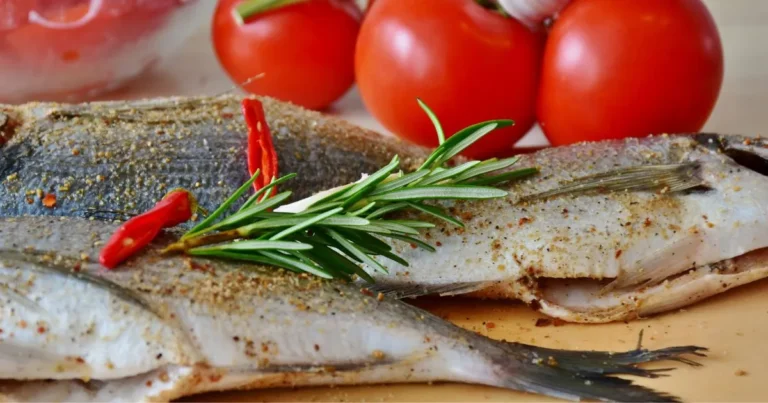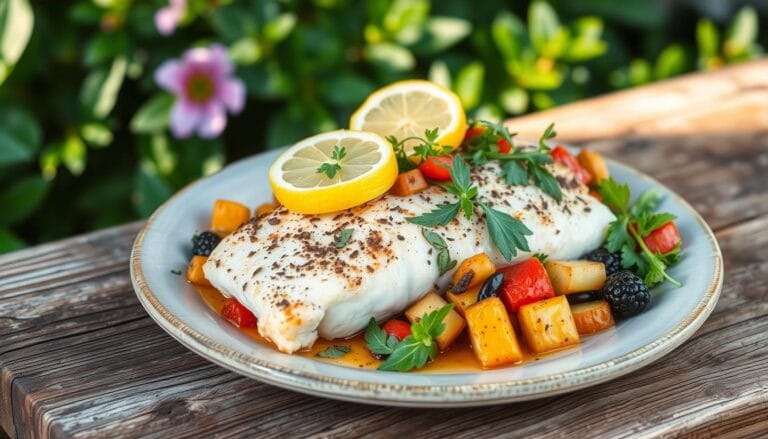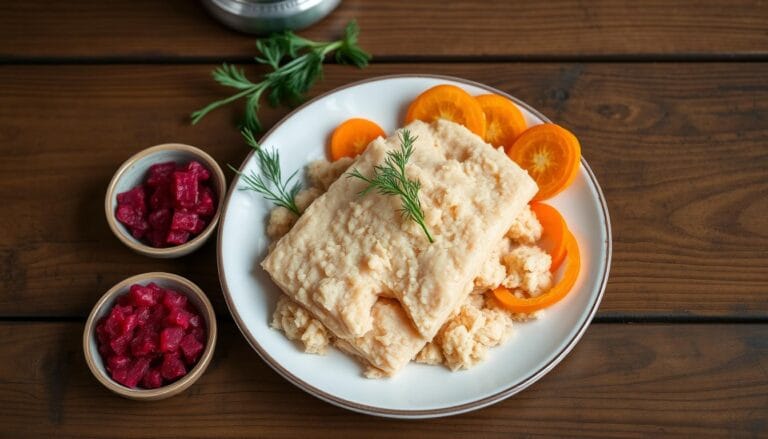How to Make the Best Fish Gravy: Simple Recipe
Imagine the smell of spices and tender fish filling your kitchen. For many, fish gravy is more than a meal—it’s a link to family, weekend fun, or a comforting taste. Our guide makes it simple to bring that warmth home. Whether you’re new to cooking or seasoned, this fish gravy recipe keeps tradition alive without losing flavor.
We’ll teach you to balance tastes, choose the best fish, and steer clear of mistakes. Every bite will celebrate the dish’s rich history.
Find out why fish gravy is a favorite in Indian kitchens and how it fits today’s tastes. This guide takes you through every step, showing that being true to tradition and simple can go together.
Table of Contents
Key Takeaways
- Learn to make restaurant-quality fish gravy with everyday ingredients.
- Understand regional twists while mastering a foolproof method.
- Get tips to adjust spice levels and textures to your preference.
- Discover how to store leftovers without losing flavor.
- Confidence to experiment with your own variations after mastering the basics.
Understanding Fish Gravy: An Introduction to This Flavorful Dish
Fish gravy is a key part of indian food fish curry. It’s known for its bright spices and deep flavors. The dish pairs tender fish with a smooth sauce that’s sweet, salty, and tangy. It’s loved in coastal kitchens and modern homes alike. Let’s explore why it’s so popular around the world.
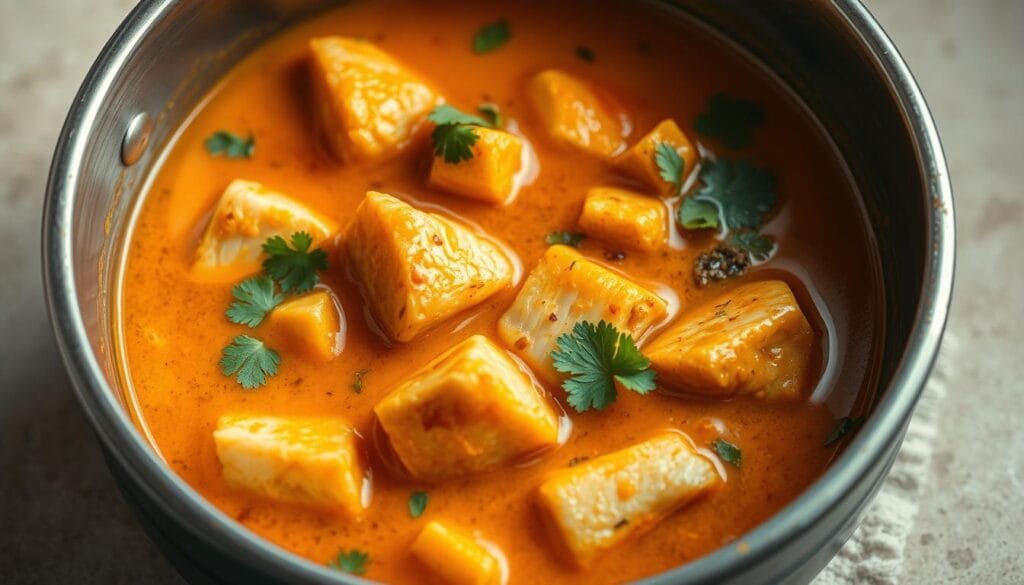
What Makes Fish Gravy Special
Fish gravy’s charm comes from its mix of tastes. Spices like cumin, coriander, and red chili add depth. Coconut milk or yogurt makes it creamy. The fish’s mild taste lets the sauce take center stage, offering a perfect balance of boldness and balance.
The Origins of Fish Curry in Indian Cuisine
Fish curry comes from India’s coastal areas, like West Bengal and Kerala. These places have a rich fishing history. They used local ingredients like mustard oil or coconut to make their own special dishes. Over time, families shared these recipes, showing how food ties culture and geography together.
Fish Gravy vs. Fish Curry: Terminology Explained
Terms like fish curry and fish gravy are often mixed up. In India, “curry” means any spiced dish, and “gravy” is the sauce. In the U.S., “fish curry gravy” might mean the same thing. This shows how language affects how we talk about food.
Essential Ingredients for the Perfect Fish Gravy Recipe
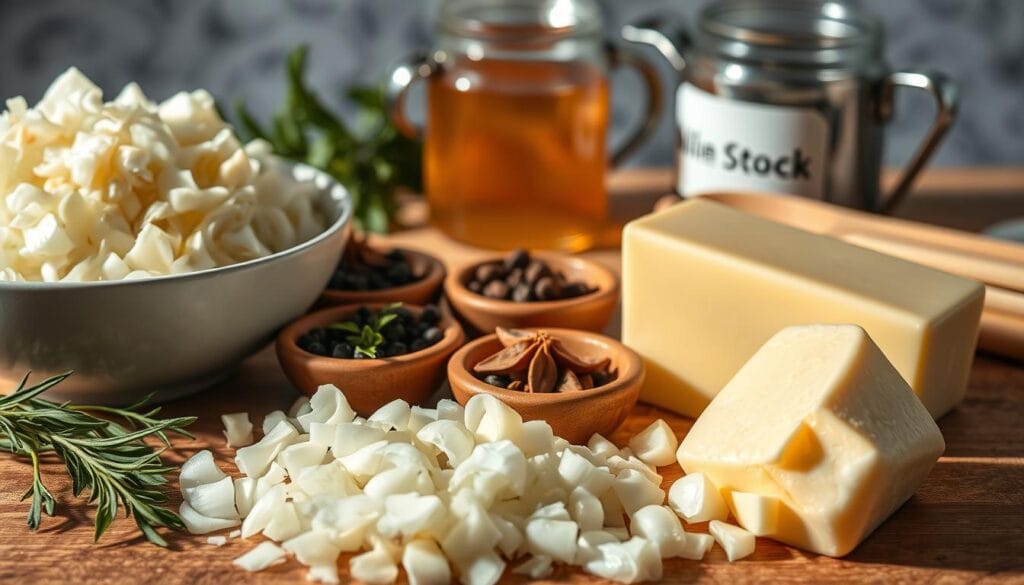
Making a tasty fish gravy starts with the right stuff. Whether you stick to a classic fish gravy recipe or try new things, these ingredients are key. They help keep your dish balanced and true to its roots.
Let’s break down what you need:
Selecting the Right Fish for Your Gravy
Firm, white-fleshed fish like cod, tilapia, or snapper is best. Look for fish masala-friendly fish at your local market. Fresh fish is great, but thawed frozen fillets work too.
Spices That Create Authentic Flavor
A classic fish masala mix has turmeric, coriander, cumin, fenugreek, and red chili powder. You can use store-bought mixes like Rajah or Swad. Just adjust the amount to your liking.
Base Ingredients You’ll Need
- Onions and tomatoes are the foundation of most gravies.
- Garlic and ginger add a rich flavor. Use fresh or frozen minced.
- Neutral oils like coconut or vegetable oil are perfect for the dish.
Optional Add-ins for Enhanced Taste
Make your fish gravy recipe even better with coconut milk for creaminess. Add dried curry leaves for a nice aroma or tamarind for a tangy twist. Vegetables like okra or bell peppers bring texture and color.
With these ingredients, you’re all set to create a dish that’s both traditional and flexible. Each ingredient plays a part in making that perfect, aromatic sauce.
Preparation Before Cooking: Setting Yourself Up for Success
Mastering fish gravy begins with good preparation. A messy kitchen can lead to mistakes. So, clear your counters and gather everything before you start cooking.
Here’s how to set up your workspace:
- Measure all spices and keep them within reach.
- Chop onions, tomatoes, and ginger first—store in labeled bowls.
- Wash and dry fish, removing scales and bones if required.
Proper fish prep is key for even cooking. Dry the fish with paper towels to prevent steaming. Cut it into uniform pieces for consistency. Marinate the fish in yogurt or lemon juice for 20 minutes to make it tender.
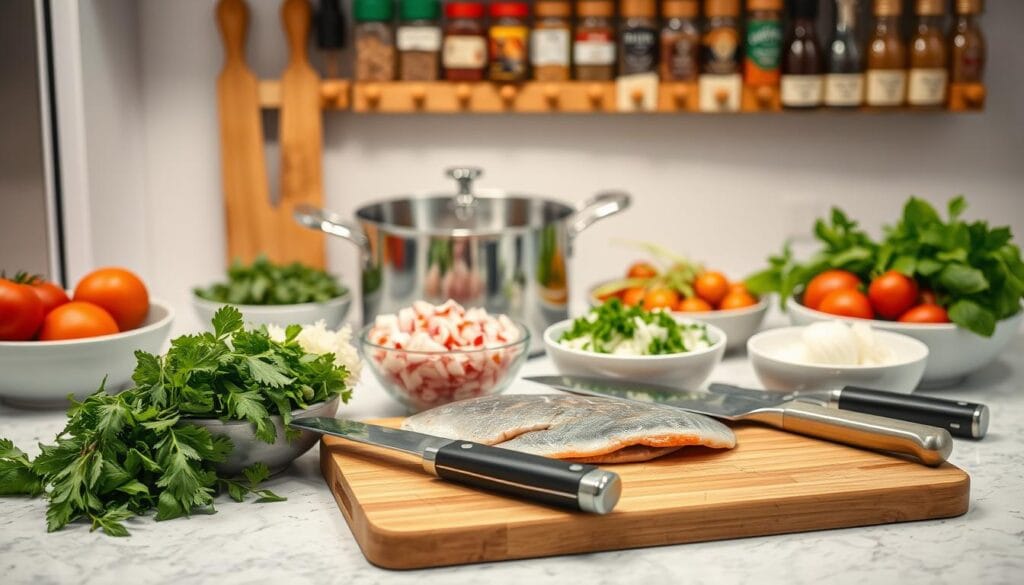
| Tool | Why It Matters |
|---|---|
| Heavy-bottomed pot | Maintains steady heat for simmering gravy |
| Sharp knife | Ensures clean cuts for even cooking |
| Wooden spoon | Prevents scratching non-stick pans |
Make sure your knives are sharp—dull blades can tear the fish. Use a slotted spoon to handle delicate pieces during cooking. Good prep saves time, letting you focus on flavor. Follow these steps, and your fish gravy will be top-notch every time.
Step-by-Step Fish Gravy Recipe for Beginners
Learning the fish gravy recipe is easy with these steps. Follow our guide to get the flavor and technique right:
Marinating the Fish
Start by marinating your fish in yogurt, lemon juice, and salt for 15-30 minutes. This makes the fish tender and adds a tangy taste.
- Combine ½ cup yogurt, 2 tbsp lemon juice, and 1 tsp salt in a bowl.
- Coat fish pieces evenly, ensuring all sides are covered.
- Let rest in the fridge while you prepare the fish curry gravy base.
Creating the Base Gravy
Start by tempering whole spices in hot oil. Sauté onions until golden, then add ginger, garlic, and a spice mix of cumin, coriander, and turmeric.
Cooking Times and Temperatures
| Fish Type | Cooking Time |
|---|---|
| White fish | 6-8 minutes |
| Salted fish | 10-12 minutes |
| Firm fish (cod, haddock) | 7-9 minutes |
Simmer the fish curry gravy over medium-low heat to prevent burning. Watch for the aroma to get stronger as it’s ready.
Achieving the Perfect Consistency
- Thin runny gravy? Stir in 1 tbsp cornstarch slurry.
- Too thick? Add ½ cup water or coconut milk.
- Simmer uncovered until desired thickness is reached.
Adjust the seasonings to taste. Gently fold in the marinated fish for the last 3-4 minutes. Serve hot with rice or bread.
Common Mistakes to Avoid When Making Fish Curry Gravy
Even seasoned cooks face hurdles when preparing fish curry gravy. These tips help you spot and fix issues before they spoil your dish.
Overcooking the Fish
Overcooked fish turns dry and stringy. Check for flaky flesh by gently flaking with a fork. Add fish toward the end of cooking to retain moisture.
Balancing the Spices
Test flavors as you go. If spice mix feels too sharp, fold in a squeeze of lime or a dash of coconut milk. Bitter notes? A pinch of sugar or yogurt can restore balance.
Texture Problems and Solutions
| Problem | Solution |
|---|---|
| Gravy too thin | Whisk cornstarch with water and stir in slowly |
| Gravy too thick | Add broth or water 1 tablespoon at a time |
| Grainy texture | Sieve tomato paste or blend onions finely |
| Separated oil layer | Simmer gently to reincorporate fats |
Remember: Adjust seasonings gradually. Small tweaks fix most issues without overhauling the fish curry gravy entirely.
Regional Variations: Chettinad Fish Curry and Beyond
Indian food fish curry changes with each region, each with its own tale. Fish curry chettinad is known for its bold heat and special spices. It comes from Tamil Nadu’s Chettinad area, using star anise, fennel seeds, and dried red chilies. Coconut milk is added to balance it out.
Let’s see how different places make this classic dish their own:
- Chettinad: Smoky spices like bay leaves and cinnamon add to the fiery fish curry chettinad.
- Kerala: Coconut-based gravies with tamarind make tangy, creamy curries.
- Bengal: Mustard seeds and poppy seed pastes give rich, earthy tastes.
- Goa: Portuguese touches add vinegar and wine to coastal curries.
- Andhra: Peppery heat is key, with tamarind and red chilies.
Making these styles at home is easy. Use common spices instead of hard-to-find ones. Start with store-bought curry powder. Try different regional flavors to enjoy authentic Indian fish curry without the hassle. Whether you like the smoky Chettinad or the creamy Kerala, there’s something for everyone.
Mastering the Fish Masala: The Spice Blend That Makes the Difference
The fish masala is at the heart of great fish gravy. It’s a mix of spices that gives it its unique taste. Whether you buy it or make it yourself, knowing about it opens up new possibilities in cooking.
Store-Bought vs. Homemade Fish Masala
Ready-made blends from brands like MDH, Shan, or Everest are quick and easy. They save time but might not be as fresh or customizable. Making your own blend lets you adjust the heat and flavors to your liking. It’s a trade-off between convenience and personal touch.
Creating Your Own Signature Spice Blend
Begin with a basic mix: 2 tbsp coriander powder, 1 tbsp cumin, 1 tsp turmeric, ½ tsp red chili powder, and 1 tsp fennel powder. You can tweak these amounts to fit your taste. For different flavors, try these:
- Add fish masala with ½ tsp amchur (dried mango powder) for a tangy Chettinad taste.
- More cumin and less chili for a milder, earthier flavor.
- Roast whole spices like cloves and cinnamon before grinding for richer taste.
How to Store Fish Masala for Future Use
After mixing, keep your fish masala in a sealed container, away from light. Glass jars are best to keep moisture out. Homemade blends last up to 3 months if stored right. Store-bought mixes usually last longer, but always check the expiration date.
Pairing Your Fish Gravy With the Perfect Side Dishes
Make your fish gravy even better by picking sides that match its flavors and textures. Whether you stick to old favorites or try something new, the right sides can make the meal complete.
- Traditional Favorites: Enjoy fish gravy with fluffy basmati rice, fragrant jeera rice, or coconut rice. It also goes great with crispy roti or flaky paratha bread.
- Fusion Inspiration: Add a twist by tossing fish gravy over pasta or serving it with roasted veggies for a filling dish.
| Traditional Pairings | Modern/Fusion Pairings |
|---|---|
| Raita (yogurt side) | Quinoa salad |
| Butter naan | Whole-grain toast |
| Papadum | Stir-fried greens |
For drinks, choose something cool like sweet lassi or tangy chaas. White wines with citrus or crisp IPAs can also pair well with spicy fish gravy.
Remember, the key is to let the fish gravy be the star. Mix textures and flavors to create a balanced meal. Try crunchy with soft or sweet with savory.
Health Benefits of Including Fish Curry in Your Diet
Fish curry gravy is not just tasty; it’s also good for you. When made with care, it can be a healthy choice. Let’s see how to make it both tasty and nutritious.
Nutritional Profile of Fish Gravy
A serving of fish curry gravy has 250–350 calories, based on what you add. Fish is full of protein and omega-3s, which are great for your heart and brain.
Spices like turmeric bring curcumin, a fighter against inflammation. Fenugreek seeds help control blood sugar, fitting today’s diet trends.
Making Your Fish Curry Healthier
- Reduce oil: Sauté with little oil or use non-stick pans.
- Boost veggies: Add spinach, okra, or bell peppers for more fiber and vitamins.
- Choose lean fish: Pick cod or haddock instead of oily fish.
- Lighten coconut milk: Use low-fat coconut milk or yogurt instead of full-fat.
Making small tweaks can make fish curry gravy healthier. Focus on using whole foods and careful seasoning. This way, you keep the tradition while boosting health.
How to Store and Reheat Fish Gravy
Learning how to store your fish gravy recipe can make it last longer. The right methods keep the taste fresh and ensure it’s safe to eat. Here are some tips to keep your gravy in top shape:
“Cool dishes to room temperature before storing to avoid moisture buildup,” advises culinary expert Chef Maria Lopez.
Refrigeration Guidelines
First, let leftovers cool down to room temperature. Then, put them in an airtight container. Keep it in the fridge for up to 3 days. Use containers made of glass or BPA-free materials to keep it fresh.
Letting the gravy rest for a bit helps the flavors mix better. This makes it perfect for meal prep.
Freezing Options for Batch Cooking
Freeze portions in labeled, freezer-safe containers for up to 3 months. If you’re using delicate fish like cod or haddock, separate the pieces. Here’s a table to help you store it right:
| Storage Method | Time Frame | Best Practices |
|---|---|---|
| Refrigerator | 2–3 days | Airtight containers |
| Freezer | 2–3 months | Label with dates |
Best Practices for Reheating
To reheat refrigerated gravy, use the stovetop on medium-low heat. For frozen portions, thaw them in the fridge overnight first. Here’s how to do it:
- Add a splash of water if needed to adjust consistency.
- Heat until steaming but avoid boiling to prevent fish from flaking apart.
- Check internal temperature reaches 165°F (74°C) for safety.
For small portions, microwaving works well. Use 50% power in 30-second bursts, stirring between intervals.
Adapting Traditional Indian Fish Curry for American Kitchens
Bringing indian food fish curry into American kitchens is easy. Swap curry leaves for bay leaves or fresh cilantro. Use garlic powder or onion powder for asafoetida’s earthy taste.
Choose stainless steel pans or nonstick options instead of kadhai woks. This makes cooking simpler.
“Authentic doesn’t mean complicated. Substitute thoughtfully, and the soul of the dish stays intact.”
Adjust the spice to please milder tastes. Use less green chilies and add red pepper flakes for heat. McCormick or Penzeys have great garam masalas for spice blends.
For those short on time, slow-cook fish curry in a Crock-Pot® on low for 4-6 hours. This keeps the fish tender and flavorful.
- Use pantry staples like paprika for Kashmiri chili.
- Replace coconut milk with almond milk for a dairy-free option.
- Swap mustard oil with olive oil; adjust cooking time slightly.
Make sure the fish is just flaky to avoid overcooking. Serve with rice or quinoa for a gluten-free meal. These changes keep the essence of indian food fish curry alive, making it perfect for today’s American kitchens.
Conclusion: Enjoying Your Homemade Fish Gravy Journey
Learning to make fish gravy is more than just following steps. It’s a journey of discovery. Every time you make it, you connect with the traditions behind it. Start by trying different fish, like catfish or cod, and adjust spices like turmeric or cumin to your taste.
Whether you’re making a classic Indian fish gravy or adapting it for American kitchens, the key is balance, patience, and detail. These principles are what make the dish great.
Sharing your fish gravy with loved ones makes meals special. Serve it with rice, naan, or veggies to show off its rich flavors. Even small changes can make a big difference—try adding coconut milk for creaminess or swapping chili peppers for less heat. The dish’s beauty is in its ability to adapt.
As you get better, try different regional styles like Chettinad fish curry or coastal takes. Share your experiences and tips online. Every batch you make helps you get better, so don’t be afraid to tweak recipes to your liking. Keep your fish gravy fresh, vibrant, and true to your taste.
Have questions or want to try something new? Join culinary communities to learn more. The journey of perfecting fish gravy is ongoing. Celebrate each step and let your passion for cooking guide you. Bon appétit!
FAQ
What is the difference between fish gravy and fish curry?
Can I use frozen fish for the fish gravy recipe?
What types of fish work best for making fish curry gravy?
How can I balance the spices in my fish curry to suit my palate?
Are there any health benefits to including fish curry in my diet?
What are some common mistakes to avoid in fish gravy preparation?
How can I store leftover fish gravy?
Can I make fish gravy ahead of time?
What side dishes pair well with fish curry?
How do I create my own fish masala blend?
There are no reviews yet. Be the first one to write one.


